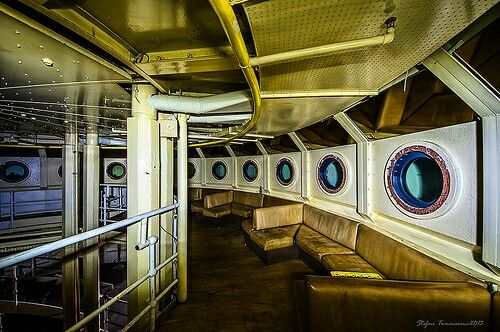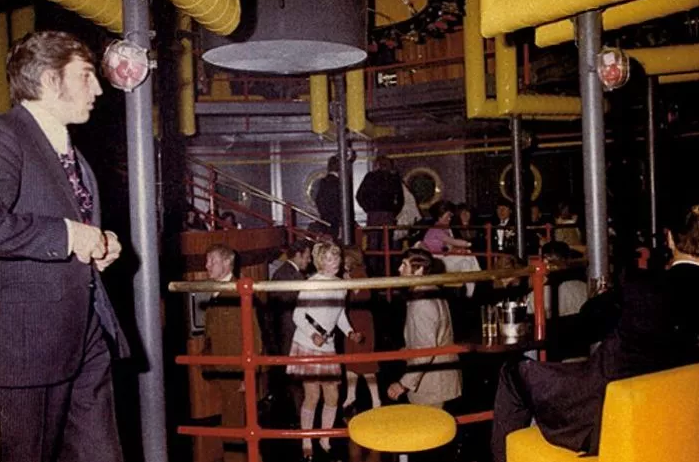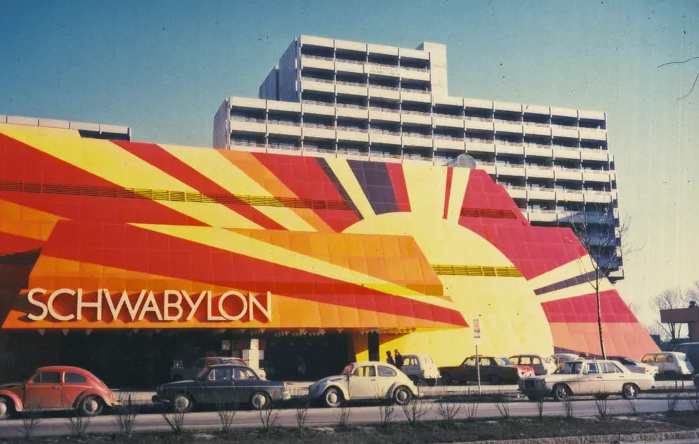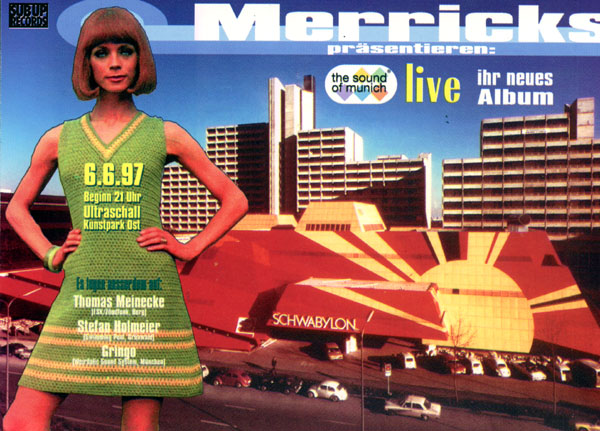History of Schwabylon
Wild '70s
In the 1970s, the construction industry was booming. Lots of different architectural styles were introduced, and a huge number of buildings that couldn't be more different were built in Germany's larger cities. Brutalist concrete blocks, simple modern detached houses, and entire housing estates were built in a few years: it was a really exciting time!
The '70s also saw a boom in nightlife. New, exclusive clubs opened up all over, making nightlife a 24-hour reality. We have all heard the stories of drug abuse on the rise, the increase of organized crime in such places, and the impact of major social or cultural changes. All of this had a big impact on the party scene of the '70s.
These cultural and social changes didn't just stop at everyday life, either. In districts like Schwabing (Munich), you'll find lots of galleries, artists' workshops, and well-known clubs, which have made their mark on the city's landscape. Schwabing had a lot to offer in terms of art and nightlife. People here were open to other cultures and lifestyles.
Schwabing was the epicenter of student protests, political discussions, and the starting point of resistance against authority and traditional values. But like most districts, it was pretty dull and uninspiring at first glance. In the early 1970s, the green light was given for a new building complex that would reflect all these special characteristics. This was the start of the Schwabylon project.
A completely new, unprecedented cultural center was going to revitalize the entire district. Finally, Schwabing would be as colorful and special on the outside as it is on the inside. The plan was a huge complex that was supposed to change everything, but failed completely after just a few years. Together, we'll take a look at the history of what was probably the biggest bankrupt building ever to see the light of day in Munich.
Schwabylon Complex
How did the idea of Schwabylon in Munich come about?
By the late '60s, Augsburg real estate entrepreneur Otto Schnitzenbaumer realized that something was missing in the Munich district of Schwabing: a cultural hub. He commissioned Swiss architect Justus Dahinden to design a huge building complex.
The idea was to put all the residential, commercial, leisure, and cultural facilities in one place to make sure the whole district got the upgrade it deserved. The complex was called Schwabing Babylon as it was a combination of the Schwabing district and Babylon – the largest cultural center of the ancient Orient.
What did the Schwabylon look like?
If you look at old photos from the time after its construction, the almost windowless colossus strikes your eye. The Schwabylon looks like a pyramid in the bright colors of the rising sun, with the gray, plain facade of a Holiday Inn in the background. To the right, the deep blue Yellow Submarine catches our eye—named, of course, after the Beatles' 1968 song.
The Schwabylon complex itself comprised a wide range of buildings, including an entire hotel with shops. There were also regular offices and apartments. In the main building, the actual Schwabylon, visitors could choose from almost 100 stores, boutiques, and galleries. Twelve restaurants and a beer garden with mature trees gave the place a rustic atmosphere.
The Schwabylon complex also had a classic amusement arcade, a movie theater, and various sports facilities, including an artificial ice rink. In the underground area, a Roman-style thermal bath and swimming pool beckoned wellness enthusiasts to linger. And of course, the absolute highlight was the Yellow Submarine, which was located right next to the Holiday Inn.
The Schwabylon, with all the areas that went with it, was a great source of hope—and not just for its owner, Otto Schnitzenbaumer. The building complex was supposed to bring about an economic upturn. His goal was to inspire locals and tourists alike! After all, the Schwabylon had everything people needed. Looking back, though, it might have been a bit much. But first, let's take a closer look at what made the Schwabylon so special at the time.
Design and Architecture of Schwabylon
We've already seen that the main building's architecture and color scheme were truly unique. The almost windowless colossus with a bit of a brutalist and futuristic style stands out from its surroundings, even without the garish color. Architect Justus Dahinden had already presented a very similar design concept with the milestone of his career, the Pyramid at the Lake in Zurich, Switzerland.
And it wasn't just the outside that showed rebellious tendencies: There were no stairs in the entire building. Instead of stairs, there were ramps between the floors, although this was probably more about standing out from the classic design of such building complexes. It wasn't the first building to be accessible this way, but it's still pretty innovative architectural design.
Early Sustainability Concept
What was particularly interesting about the Schwabylon was the consideration of aspects that are called sustainability today. We don't know much about how the building complex was designed, but what we do know is that it's a great example of some really innovative approaches in construction.
Those responsible for the construction and interior design of the Schwabylon used recycled materials as much as they could. After all, this building was meant to be special. The deliberate greening of the roofs and the adaptability of the floor plan due to modular construction rounded off architectural ideas that have long since become current trends in the construction industry. The Schwabylon was, therefore, well ahead of its time.
Yellow Submarine: Highlight of Schwabylon
In 1971, two years before the main building of the Schwabylon was built, a nightclub opened next to it, which was primarily known as "Shark Disco". And this nickname was actually the program.
The Yellow Submarine was an underground club with three floors and a huge water tank surrounding it. There were over thirty sharks and a few sea turtles swimming around in around 650,000 liters of seawater—real animals, unfortunately. At the time, this was an absolute highlight that attracted lots of visitors. After all, there weren't many large aquariums like this one in Germany at the time.
True to the name of the club, the interior of the Yellow Submarine was designed to look like a submarine interior. A railing connected the 12-meter-high (39.4-foot) building across three floors. The sea creatures could be seen directly through portholes, which made the building a real eye-catcher.
Due to this very special and unique atmosphere, the Yellow Submarine quickly became a famous nightclub. It soon became one of the most expensive and well-known nightclubs in the city, if not one of the most famous in Germany.
However, the Yellow Submarine was not only a great venue for parties. The club could also be booked for private or business events. In addition to the classic disco, visitors could enjoy exotic dishes in the themed restaurant. For example, they could eat grilled shark while watching animals through the portholes—how romantic!
Were there real sharks in the Yellow Submarine?
This is probably something you'll be thinking about if you have read the article closely. How do a wild disco and quiet-loving animals like sharks and sea turtles fit together? That's right; not at all. The idea of animal welfare wasn't a particularly widespread concern in the '70s.
Cute monkeys as pets, your own hyenas, direct imports of tropical fish whose natural habitats were endangered: this was quite normal at the time. First in 1973, international rules were established in CITES, also known as the Washington Convention on Endangered Species, which severely limited the unrestricted trade in endangered species.
The sharks and sea turtles for the Yellow Submarine always came directly from Mexico—a lucrative business for everyone involved. Back in 1971, shortly after the Yellow Submarine opened, there was a lot of water damage, according to aquarium officials. One Sunday morning, the aquarium overflowed, and the whole interior was underwater for several meters (feet). All the sharks that were swept out of the tank died, but the sea turtles survived the disaster.
But even after that, things didn't get any better for the newly arrived animals. It was impossible to keep adult sharks of up to 1.8 m (5.9 feet) in length in this water tank permanently. In fact, only young sharks were kept there, and they were imported again and again. This was because the smoke-filled air and cigarette butts from drunken guests often shortened their lifespan to just a few months.
It's hard to imagine how the quality of life of the animals could have been improved, given that the man responsible for this tank wasn't a marine biologist or any kind of expert on marine life, but simply the owner of several large pet shops in Munich.
Failure of Schwabylon Complex
In the end, the entire concept of the Schwabylon proved to be a complete waste of money. On one hand, the entire project aroused great interest and attracted media attention. On the other hand, the Schwabylon complex was simply too big to be economically sustainable in the long term. Many aspects just didn't fit. Despite the numerous inner courtyards and landscaped gardens, it remained quite dark throughout the entire complex due to the solid construction.
The oil crisis of 1973, just a few months after the Schwabylon opened, put an abrupt end to the economic boom in Germany. The Arab countries imposed an embargo on international trade in raw materials. One of these resources was oil. We've recently experienced for ourselves what this can mean, at least in the early stages. The whole economy ground to a halt in 1973.
The consequences were bans on driving, energy-saving tips from the government, and rethinking energy policies. The Schwabylon and the Yellow Submarine were caught off guard by these circumstances. Oil prices shot up more than fourfold, and high operating costs caused rents to explode. People's purchasing power and willingness to spend money in all the different areas of the complex quickly fell to zero.
The oil crisis had a long-lasting impact. In 1979, just six years after the opening, the remaining six store tenants were given notice and the demolition of the main Schwabylon building began.
The Yellow Submarine also had to deal with the fallout of the economic situation. Just feeding the animals in the water tank cost about 500 DM a day, and the technology for maintaining such a large facility was very expensive. The club kept going, but soon there were no real animals left. Instead, screens were installed behind the portholes. From an animal welfare perspective, that would have been the best choice from the start.
The club was getting on in years and needed renovation in the early '80s. As of 1983, this trendy bar was known as "Aquarius". The Aquarius was more than just a club for events and parties. It was also a popular meeting place that retained its original charm.
In order to make space for something new, the Aquarius was closed in 2013 and the building was demolished, despite strong public protests. Today, the Schwabinger Tor is at the same location, a modern building complex of leisure and shopping facilities. Was this a good replacement for such a unique project as the Yellow Submarine? Ultimately, it's up to you to decide.
Conclusion: Schwabylon in Munich
A failed dream?
In summary, the Schwabylon project was far ahead of its time, probably just a little too far ahead. The goal of creating a completely unique, utopian leisure and cultural hub probably failed precisely because of this. It was too big, too flashy, and too difficult to maintain.
Although it fitted perfectly with the zeitgeist and style of the Schwabing district, it caused offense in too many areas. Visitors felt overwhelmed by the wealth of offers, and the operation of the Schwabylon complex was simply too expensive. The oil crisis in 1973 was the final nail in the coffin for this complex construction project.
It's a shame, especially from an architectural point of view, that the entire complex was demolished so quickly. The closing of the Yellow Submarine and the subsequent demolition also left a bittersweet aftertaste. After all, we should be concerned with preserving such unique buildings with an eventful history.
Unfortunately, not much information or pictures remain of the Schwabylon and the Yellow Submarine. What remains are the memories of a few contemporary witnesses, which have been recorded here and there. There will probably never be a comparable project again, and Munich in particular lost a huge piece of architectural history with the Schwabylon complex. At least a few film clips and images have been preserved, mainly thanks to pop culture.










